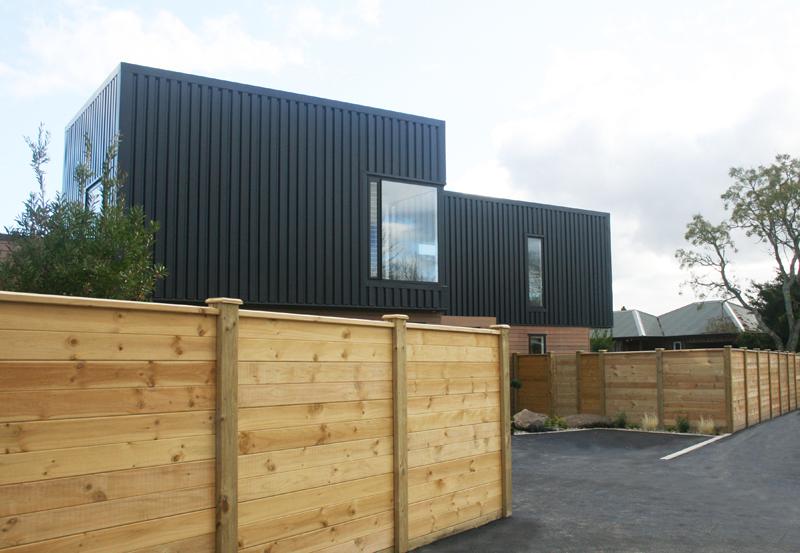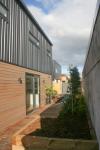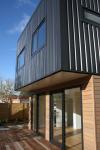Synergetic Graduation of a Simple Form

The client purchased a section which was just over a 1000sqm in the middle of suburbia, surrounded by established homes being circa 1960-1970.
Close to Waikato Diocesan School for Girls and to the Fairfield Bridge, providing easy access to Hamilton City, his intention was to achieve better utilisation of the land by removal of the existing dwelling and replacing it with three separate parcels of land, each with its own title. The two-storey house was the centre focus of the development, allowing a visual connection between all three dwellings – the other two which were a duplex.
Murray Borland of Borland Architecture Group says consideration of the District Plan and the perfect orientation positions along with consultant support in surveying and planning have been paramount in resolving the daylight to boundary angle failures within the overall development along with the creation of excellent outdoor recreational spaces.
The 454 sqm site faces north east which provides an extensive outdoor living space, designed especially for el fresco dining with a seamless transition. The stand-alone dwelling has a total floor area of 190 sqm which includes a double garage. The house has three bedrooms upstairs along with an office, two bathrooms and a walk-in wardrobe within the master suite.
Downstairs is an open plan combined living, dining and kitchen space with a separate powder room and a laundry within the garage.
Project challenges
• Restrictive day lighting angles, combined with height restrictions
• Little excavation required because the site was flat
• Capturing as much morning and afternoon sun for all three homes to allow for maximum outdoor living
Compliance
To achieve maximum utilisation of the sunlight from east to west, the design process – even though simplistic in nature – along with the site restrictions made it more complicated to comply with the district scheme.
Murray Borland says together with the planners, and especially the surveyor, they achieved the results they were looking for by stepping the design, allowing them to eliminate all the planning failures.
“Stepping the cubic linear structural form, and with the use of smart detailing of material junction, a tonal graduation of two basic materials has formed a powerful synergetic integration between the smooth black metal cladding and the warmth of cedar weatherboards.
“These connections of the sculptured clean-lined design have created a sharp, clean architectural addition that blends well with the standing mature environment.
“The simplistic form of the structure has been planned with a minimalistic approach, and sensitivity towards both sustainability and longevity. The selection of Roofing Industries’ “multi rib” cladding, which is normally used as a roofing material, has in this instance been reversed with the intention of a visual illusion reduction of its perceived height. The garage was purposely clad in cedar to make a stronger connection with the vertically profiled metal, forming a physical continuity anchoring the cedar to the surrounding environment and the connection between the two.
“Extensive use of storm water collection has been undertaken by the introduction of detention slow- release tanks which also provide water for the use on gardens. Energy efficiency is addressed through solar orientation and sunlight control, cross flow ventilation and a high level of insulation and double glazing.
“Interlocking clean-line rectilinear forms have been grouped to provide privacy on three sides but the house opens to light on the north face, constrained from overlooking neighbours. From the street there are very few signs of habitation and this is deliberately done to prevent the scale being immediately seen and instead allows the form to culminate toward the southern rear end of the house. This is purposely achieved to connect with the other three duplex structures”.
Architectural Designer
Designer Murray Borland from the Borland Architecture Group Ltd has practised architecture for over 40 years, both in private practice and as a consultant, working in Hong Kong, England, UAE and the Pacific Islands. A specialist in the field of Polynesian and ethnic architecture, he has a huge and diverse knowledge base. He has also been instrumental internationally, in innovation architecture for the bloodstock and equestrian industry in New Zealand, Australia and Hong Kong, implementing design for breeding, racing and disabled riding for the wellbeing of horses.
Murray was a foundation professional member of ADNZ in 1976-77 and held leadership positions on the National Executive from then for over a decade. During that period he was appointed as the ADNZ advisor and spokesperson on Government select committees associated with the development, education and qualification sector for the NZQA framework – these being directly related to architectural technicians.
In later years, his practice has channelled their professional skills into humanitarian architecture on an international platform for support in third world countries. This has been an opportunity to showcase examples of environmentally sustainable architecture to benefit both the poor and underdeveloped areas of mankind. In this role Murray has also provided speaking positions in Asia and the Pacific. His expertise is across an extremely broad and diverse range of sectors from military, hospitality and leisure to business space, residential and retail facilities.
The company believes “understanding, through analysis and a level of communication are the solutions to design problems, and with that comes the focus on achieving design excellence”.




